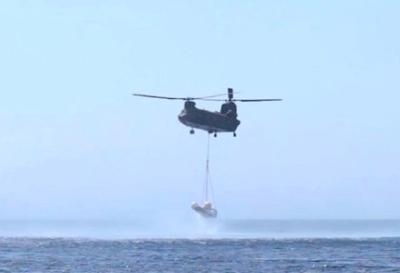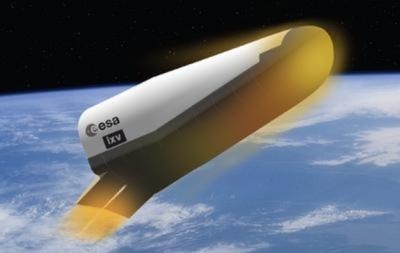Wed, Jun 26, 2013
Released From Nearly 10,000 Feet Off The Coast Of Italy
ESA’s experimental reentry vehicle passed its milestone descent and landing test on last week at the Poligono Interforze Salto di Quirra off the east coast of Sardinia in Italy. The full-scale Intermediate eXperimental Vehicle (IXV) prototype was released from an altitude of 3000 m (about 10,000 feet) by a helicopter, falling to gain speed to mimic a space mission before parachute deployment. The parachute slowed IXV for a safe splashdown in the sea at a speed below 7 m/s (23 f/s). This last step in a series of tests shows that IXV can be recovered safely after its mission into space.

The IXV project is developing and flight-testing the technologies and systems for Europe’s future autonomous atmospheric reentry vehicles. It will be launched by ESA next year on Vega, Europe’s new small launcher, into a suborbital path. It will reenter the atmosphere as if from a low-orbit mission, testing new European reentry technologies during its hypersonic and supersonic flight phases.
Previous campaigns included several water impact tests at CNR–INSEAN, a marine-engineering research institute in Rome, Italy. An instrumented subscale prototype was released at various angles and speeds to assess the best configuration for minimum impact loads.
At the Yuma Proving Ground in AZ, the multistage supersonic parachute was qualified up to the opening of the main subsonic stage. Building on these, Wednesday’s test started with the redeployment of the main subsonic parachute followed by: cutting the two ablative thermal protection covers of the parachute bridles, firing the 16 non-explosive actuators to release the four panels covering the floatation balloons, jettisoning the panels, detecting the water impact, deploying the beacons, and receiving the signal from the Cospas–Sarsat satellite network pinpointing the prototype bobbing in the sea.
An anomaly in inflating the balloons will be investigated. The vehicle was recovered from the sea and taken to land for detailed inspections and analysis.

This test highlights the importance of early inflight verification to secure a robust space vehicle design, confirming the technical direction and possibly suggesting further improvements.
“Our special thanks go to the Italian Defense and the Italian Aerospace Research Centre (CIRA) for the commitment and the excellence exhibited in performing complex air–sea–ground operations enabling the successful challenging descent and landing system test,” noted Giorgio Tumino, IXV Program Manager.
On IXV’s flight next year, the suborbital vehicle will separate from its Vega launcher at an altitude of about 200 miles. IXV will coast to 267 miles and then begin its reentry phase, recording experimental data from a large number of conventional and advanced sensors.
The entry speed of around 4.6 m/sec at an altitude of 74.5 miles will create the same conditions as those for a vehicle returning from low orbit. The mission, lasting more than 2 hours, will end with splashdown in the Pacific Ocean to await recovery and analysis.
(Images provided by ESA)
More News
Also: SkyReach Parts Support, Piper Service Ctr, Airliner Near-Miss, Airshow London The Judge overseeing Icon's convoluted Chapter 11 process has approved $9 million in Chapter 11 >[...]
ILS PRM Approach An instrument landing system (ILS) approach conducted to parallel runways whose extended centerlines are separated by less than 4,300 feet and at least 3,000 feet >[...]
Aero Linx: FlyPups FlyPups transports dogs from desperate situations to fosters, no-kill shelters, and fur-ever homes. We deliver trained dogs to veterans for service and companion>[...]
Also: Skydio Chief, Uncle Sam Sues, Dash 7 magniX, OR UAS Accelerator US Secretary of the Air Force Frank Kendall was given a turn around the patch in the 'X-62A Variable In-flight>[...]
Also: NBAA on FAA Reauth, DJI AG Drones, HI Insurance Bill Defeated, SPSA Airtankers The Beechcraft Denali continues moving forward towards certification, having received its FAA T>[...]
 Airborne 05.10.24: Icon Auction, Drunk MedEvac Pilot, Bell ALFA
Airborne 05.10.24: Icon Auction, Drunk MedEvac Pilot, Bell ALFA ANN's Daily Aero-Term (05.13.24): ILS PRM Approach
ANN's Daily Aero-Term (05.13.24): ILS PRM Approach ANN's Daily Aero-Linx (05.13.24)
ANN's Daily Aero-Linx (05.13.24) Airborne-NextGen 05.07.24: AI-Piloted F-16, AgEagle, 1st 2 WorldView Sats
Airborne-NextGen 05.07.24: AI-Piloted F-16, AgEagle, 1st 2 WorldView Sats Airborne 05.08.24: Denali Update, Dad-Daughter Gyro, Lake SAIB
Airborne 05.08.24: Denali Update, Dad-Daughter Gyro, Lake SAIB




